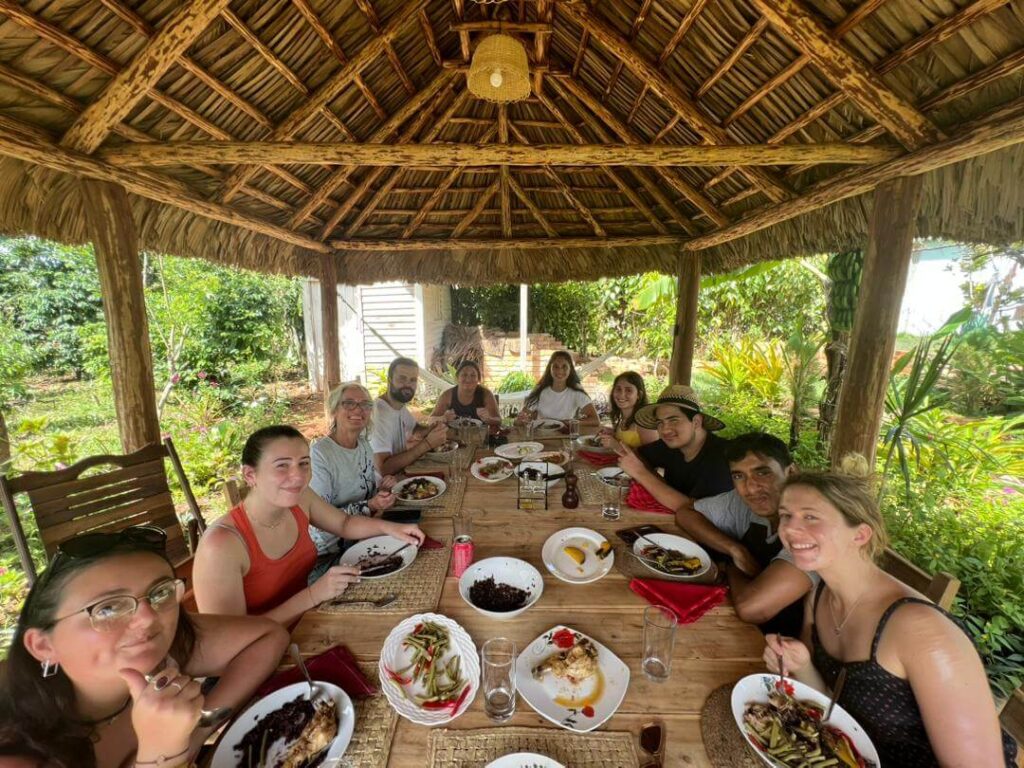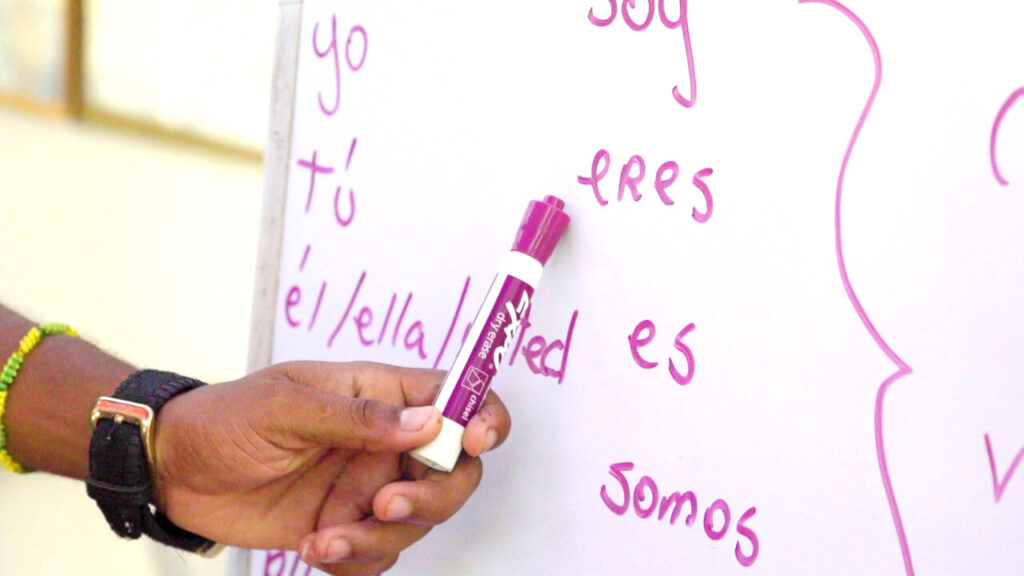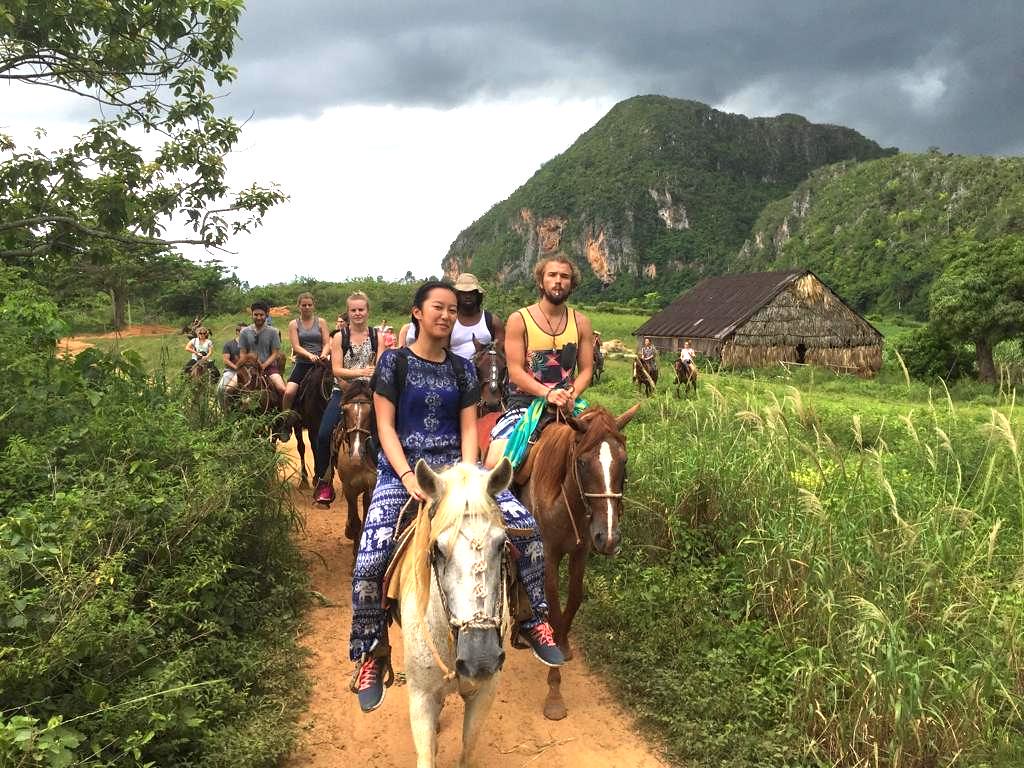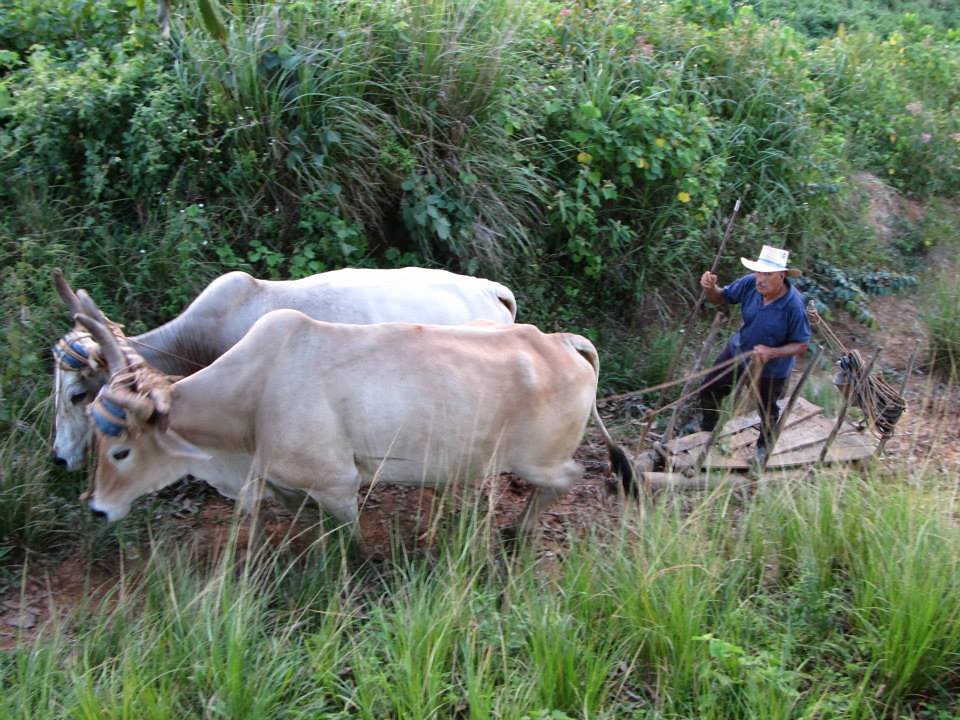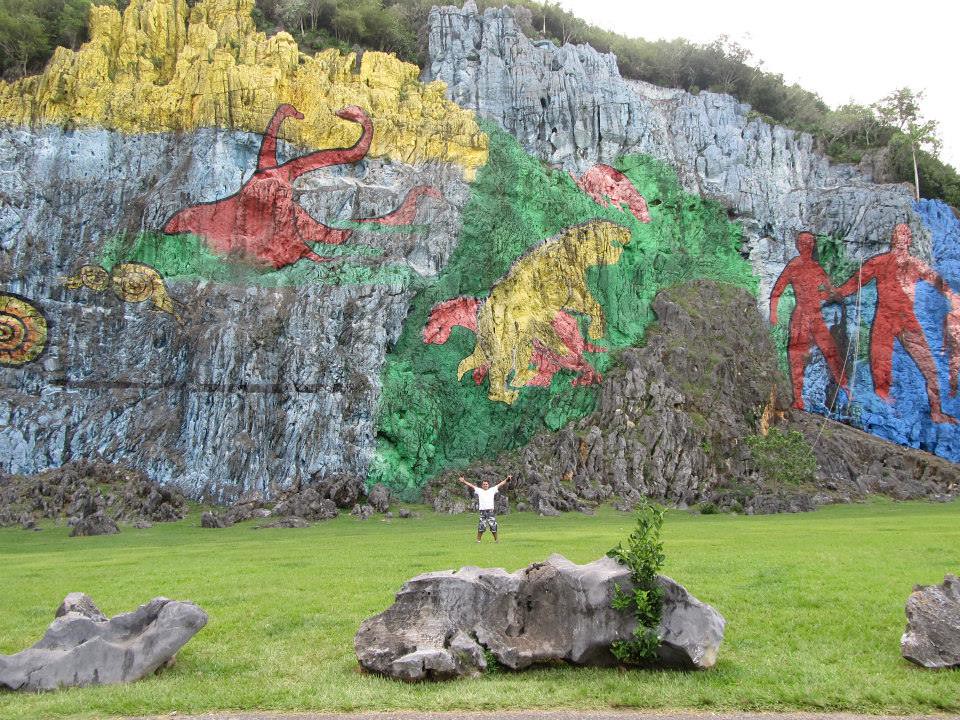Learn Spanish & Adventure in Viñales
Step back in time and enjoy traditional Cuba. Viñales is a beautiful agricultural town utilising horse power to cultivate plantations including the best tobacco fields in the country. A perfect contrast to your time in Havana here we enjoy the fresh air and natural world including stunning UNESCO heritage status limestone mountains and tobacco drying houses.
This is a one week program starting EVERY Sunday. Spanish lessons take place each morning Monday to Friday and after lunch we explore; hiking, horse-riding and cycling through some of the most wonderful landscapes in Cuba. Can be taken as a stand-alone or ‘follow on’ program. The program starts and finishes in Viñales but transportation from Havana can be arranged.
Program includes 7 nights accommodation, half board, Spanish lessons each weekeday morning with an activity every day to help you maximise your time.
Trip Profile
Duration
7 nights
price
usd 495 per week
spanish level
beginner - advanced
restrictions
18+ OR ADULT/CHAPERONE
group size
2-6
Arrival
Viñales
Departure
Viñales
accomodation
Casa particulare
meals
breakfast & lunch
season
year round
Trip Highlights
- Experience the rural heart of Viñales and dip indulgently into the natural world, hiking, horse-riding and cycling through some of the most wonderful landscapes in Cuba
- Stay in a traditional family run Casa Particulare with accommodation, breakfast & lunch plus Spanish lessons throughout
- Full week of adventure activities to explore and enjoy Viñales valley on horseback, bike and hiking
- Start dates every week!
- 18+ program with no upper age limit; minors welcome if accompanied by an adult as this program is family friendly!
- Program Managers and all Cuban crew will help you feel at home providing 24/7 support
- Support the Cuban People - complies with US travel restrictions
Overview
Program starts and finishes in Viñales BUT transportation can be arranged from Habana Vieja direct to your Casa Particulare in Viñales departing after breakfast Sunday morning and arriving lunchtime. As usual there is a ‘welcome camino’ to familiarize yourself with the neighbourhood and various services. Very quickly you will sense a totally different atmosphere and pace to the chaotic energy of Habana.
This is farming country and the horse is used to get around town and used to work the rust coloured tobacco fields. The town itself is very pretty nestled in a valley surrounded by distinctive limestone mountains. The main square is lively during the evenings with an outdoor ‘Casa de Musica’ being the central hub for nightlife.
Accommodation is shared rooms in a family run Casa Particulare. Breakfast and lunch are provided each day and features locally grown produce – usually organic. Monday to Friday Spanish lessons continue in the usual format 3 x 45 minute lessons from 09:00-11:45. After lunch there are daily activities, listed below, to help you enjoy and explore this beautiful part of the country.
What's Included
- Pre arrival support - email and/or Whatsapp - including optional airport transfers & accommodation in Habana (private taxi - $40 each way) and transfers to/from Viñales ($35 each way)
- Accommodation, breakfast & lunch provided throughout in a traditional family run Casa Particulare
- Spanish lessons Monday to Friday each morning / on the first morning there is a short written assessment and discussion to establish your level and objectives before you are allocated to a teacher - beginner, intermediate & advanced classes all catered for!
- Each day Monday to Friday an activity has been scheduled to help you enjoy and explore the town and countryside
- Impromptu social activities and 24/7 support from our amazing Program Managers to help you maximise your free time
- Possible to combine and extend programs as well as information and support should you want to continue your travels in Cuba after spending time with Corazon Cuba!
- Download our for practical information you may find useful
Description
Monday to Friday’s intensive Spanish lessons take place shortly after breakfast. Your teacher is licensed and on day one you receive a short test followed by a discussion to establish your level and objectives (OR if doing this as a ‘follow on’ program, teacher in Havana will prepare continuation classes in Viñales). Lessons take the format of 3 x 45 minute lessons each morning, with 15 minute breaks to refresh, making approximately 3 hours of Spanish lessons each day – 15 hours per week. Lessons are held from 09:00 sharp, Monday to Friday at your Casa.
The best way to explore the valley and lush plantations is as the local formers do; on horseback. This is a gentle trot through the countryside to take in the scenery and traditional farming techniques. We stop at one of the distinctive tobacco drying houses and learn more about this famous crop – and the processes involved in cultivating tobacco, drying/curing and finally how to roll a cigar. We then continue to the spectacular ‘Mirador’ viewing point before returning home late afternoon.
If you prefer, this activity can be taken as a walking tour – without the horse!
This time we enjoy exploring the valley on foot. Learning more about the various crops cultivated here including sugar cane – a refreshing cane juice helps energise us along the way. As we walk your local guide will help you understand how people live here, some of the challenges and the importance of agriculture and tourism to create a balanced and sustainable economy.
This morning we have a particularly early start as we aim to catch a spectacular sunrise with a local community, Los Acuáticos. We enjoy stories about the history – and mythology – of this community. After a coffee or fruit juice we continue to the famous ‘prehistory mural’ – actually an art piece created in the 60’s and often hyped but nonetheless a popular attraction and the location itself is very special.
Back to our Casa ready for breakfast… and Spanish classes. As the afternoon is free any sleepy heads can enjoy a well-earned siesta!
This time we hop on bicycles and head out of town and explore one of the many limestone caves that make Viñales so distinctive. Some of these caves were used as shelters for indigenous peoples and used as hideouts for runaway slaves. There is also a cave that doubles as a nightclub!
Today we take a boat trip to admire one of the most extensive cave formations with distinctive mineral and limestone formations.
Our final activity during this busy week is to learn more about the evolution of the town, different construction techniques and pointers to her future. We also learn more about the indigenous flora at the beautifully manicured botanical gardens.
Price includes ‘welcome camino’, 7 nights accommodation, breakfast & lunch plus 15 intensive Spanish lessons and activities described above.
Cost of extra night – accommodation & breakfast $40
Cost of Habana to Viñales transfer – each way $35
This program can be taken as a stand-alone program OR a ‘follow on program’. For example, 1st Sunday of each month there are two 2 week program options available, based in Habana – Learn Spanish, Dance & Culture OR Learn Spanish & Volunteer. What better way to get an all round view of Cuba than a three week program starting with two weeks in Habana followed by a week in Viñales!
Useful Information
Immaculate beaches, lush green hills, dramatic rainforests and waterfalls; imposing mountain ranges, vibrant cities steeped in history and a defiant Revolutionary chic; the island of Cuba can rightfully claim to be one of the most unique getaways on earth.
The largest and most populous island in the Caribbean, Cuba has been somewhat time warped by its socialist revolution of 1959, and that, combined with the decadence and corruption of previous regimes has made it a sunshine isle of stark contrasts. Vintage American cars roar through the streets of Havana. Horses and carts carrying water and food stumble through the countryside. Graphic revolutionary insignia adorn walls just yards from a decadent colonial palace.
Much of the island’s allure lies in its spectacular beaches and thrilling scenery. Christopher Columbus wasn’t joking when he declared in 1492 the coast of Guardalavaca to be “the most beautiful land I have ever seen.” The beaches there are like something out of a dream, so it should come as no surprise that thousands of holidaymakers head there each year to soak up the sun on the improbably white sands, dip into the warm, turquoise waters and indulge in the five star luxury that many of the hotels and resorts there provide.
While the world famous cocktails may surpass the hearty but occasionally limited food and the travelling around might be slightly more difficult than elsewhere in the Caribbean, Cuba more than makes up for this with its stunning climate, captivating history, generous charm and swinging salsa rhythms.
You need a visa (also known as Tourist Card) to enter Cuba. These are easy to buy online – we recommend the following service, see;
The standard Tourist Card is now valid for 90 days.
You need to buy this at least 3 days before travel. The process is easy – standard questions – you will then be emailed an e-visa code that you need to input into a D’Viajeros form your airline will ask you to complete prior to flying. This form is also straight foward and you should have it available (hard or soft copy on your phone) to show when you board your flight and when you arrive in Cuba.
For US citizens / guests travelling directly from the US to Cuba we recommend the following service, see;
All our programs comply with ongoing US travel restrictions and are 100% legal for US and non US citizens alike. It is no longer necessary to apply to ‘OFAC’ for special permission to visit Cuba. When flying direct from the US to Cuba your airline will require you to sign and retain a one page ‘affidavit’.
This document lists 12 permitted categories of travel to Cuba. Please simply tick the box marked ‘SUPPORT THE CUBAN PEOPLE’. This is a travel category our programs comply with.
Following the abolition of the CUC (convertible peso) in 2021 the only official national currency now in circulation is the Cuban Peso (also known as ‘Moneda Nacional’). However, USD and EURO cash is widely accepted and easily converted into local currency.
Bank cards drawn on US banks are still not accepted in Cuba so US residents should bring sufficient USD cash for all your spending requirements while in Cuba.
For other visitors, to ensure maximum flexibility and to achieve the best rate of exchange, we also recommend cash – ideally USD or EURO. However, bank ATM machines are widely available throughout Cuba. Only government owned business accept card payments.
WiFi is still not widely available in Cuba except on a pay as you go basis in government hotels and internet cafes. However, inexpensive SIM cards can now be purchased on arrival – our local team can help you buy these. It may be advisable to ensure your phone is ‘unlocked’ and/or has a VPN service to ensure continuity of services when in Cuba. The situation is constantly evolving and improving so there is no need to be ‘offline’ for extended periods – unless you would like to be!
Cuban’s are big meat eaters but there is a varied and plentiful supply of excellent locally produced seasonal fruit and vegetables as you would expect from a tropical country.
However, strict vegetarians should please ask as often the ubiquitous black and brown beans served with every meal is started with some pork fat. The good news is that though repetitive Cuban food is very healthy with virtually no processed foods and almost organic given a of shortage of pesticides.
CORAZON CUBA REVIEWS
